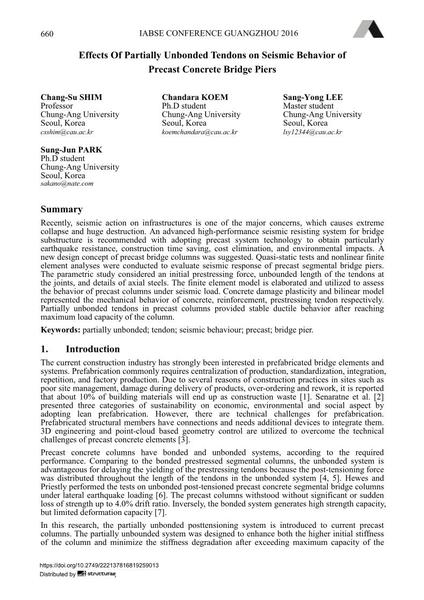Effects Of Partially Unbonded Tendons on Seismic Behavior of Precast Concrete Bridge Piers

|
|
|||||||||||
Détails bibliographiques
| Auteur(s): |
Chang-Su Shim
Chandara Koem Sang-Yong Lee Sung-Jun Park |
||||
|---|---|---|---|---|---|
| Médium: | papier de conférence | ||||
| Langue(s): | anglais | ||||
| Conférence: | IABSE Conference: Bridges and Structures Sustainability - Seeking Intelligent Solutions, Guangzhou, China, 8-11 May 2016 | ||||
| Publié dans: | IABSE Conference, Guangzhou, China, 8 – 11 May 2016 | ||||
|
|||||
| Page(s): | 660-665 | ||||
| Nombre total de pages (du PDF): | 6 | ||||
| Année: | 2016 | ||||
| DOI: | 10.2749/222137816819259013 | ||||
| Abstrait: |
Recently, seismic action on infrastructures is one of the major concerns, which causes extreme collapse and huge destruction. An advanced high-performance seismic resisting system for bridge substructure is recommended with adopting precast system technology to obtain particularly earthquake resistance, construction time saving, cost elimination, and environmental impacts. A new design concept of precast bridge columns was suggested. Quasi-static tests and nonlinear finite element analyses were conducted to evaluate seismic response of precast segmental bridge piers. The parametric study considered an initial prestressing force, unbounded length of the tendons at the joints, and details of axial steels. The finite element model is elaborated and utilized to assess the behavior of precast columns under seismic load. Concrete damage plasticity and bilinear model represented the mechanical behavior of concrete, reinforcement, prestressing tendon respectively. Partially unbonded tendons in precast columns provided stable ductile behavior after reaching maximum load capacity of the column. |
||||
| Mots-clé: |
pile de pont
|
||||
